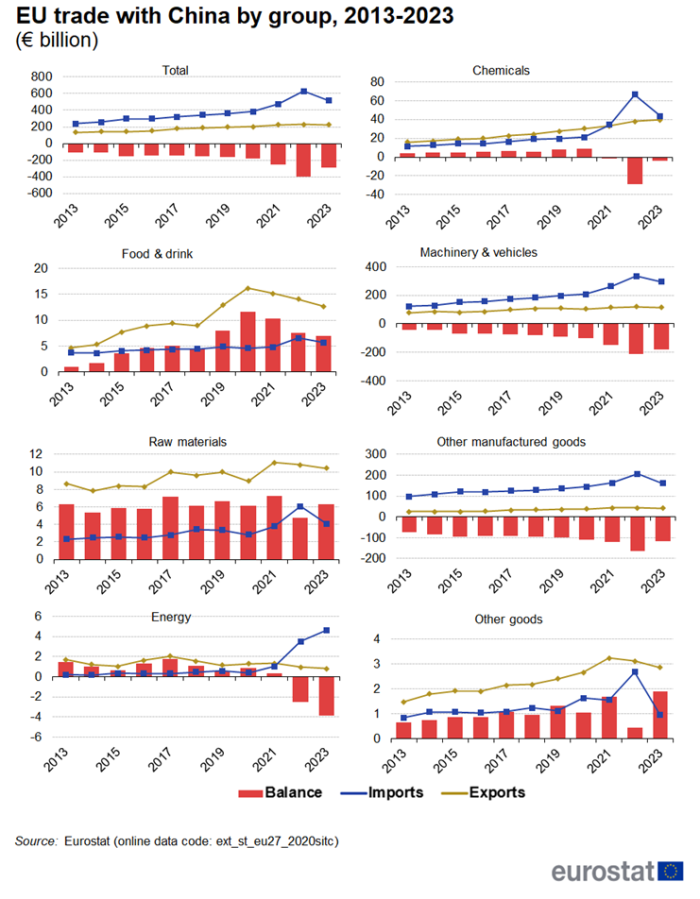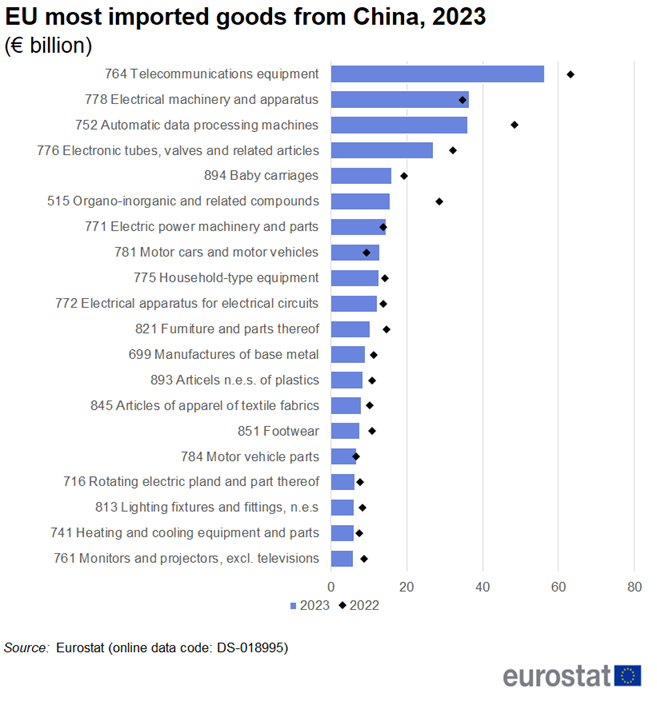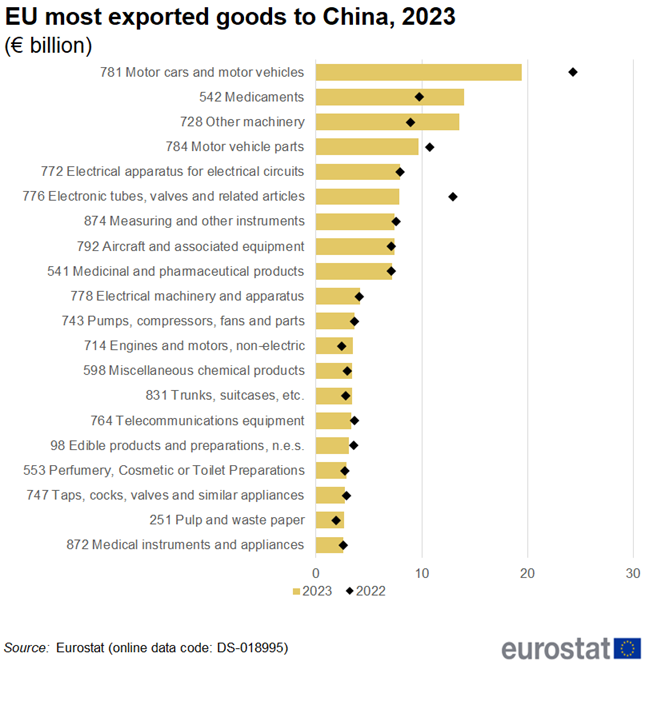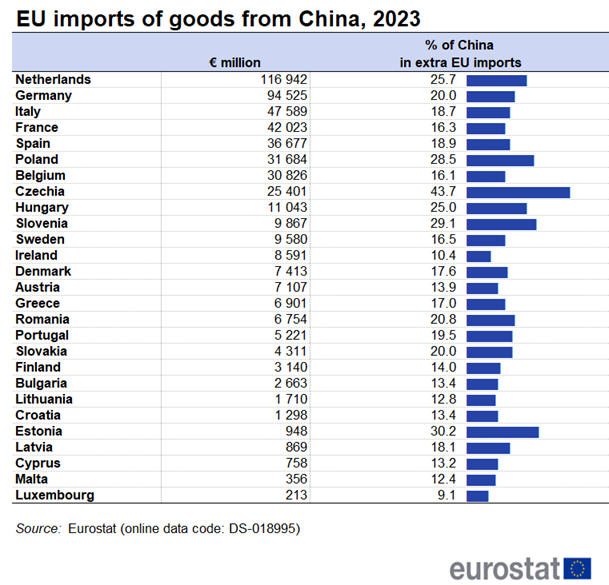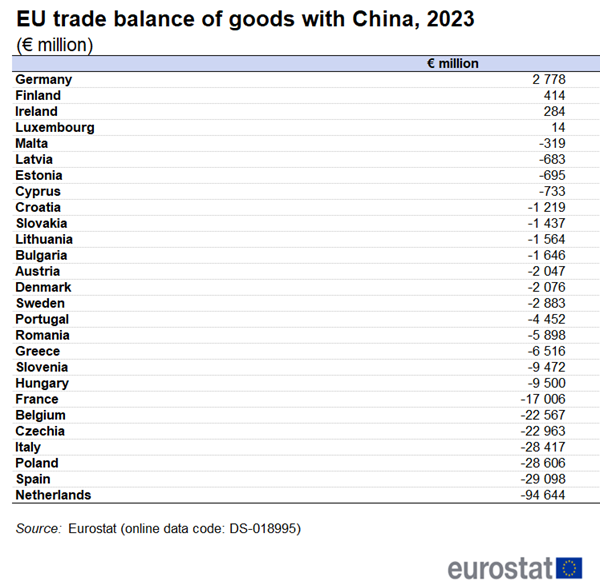China-EU - international trade in goods statistics
Data extracted in February 2024
Planned article update March 2025
Highlights
EU trade in goods with China, 2013-2023
This article provides a picture of the international trade in goods between the European Union (EU) and China. It analyses the type of goods exchanged between the two economies and the shares of each EU Member State in those exchanges.
This article is part of an online publication providing recent statistics on international trade in goods, covering information on the EU's main partners, main goods traded, specific characteristics of trade as well as background information.
Full article
Recent developments
EU exports to China did not change much between January 2022 (€18.3 billion) and December 2023 (€18.1 billion) although they reached a low of €17.7 billion in April 2022 and a high of €20.9 billion in February 2023 (Figure 1). Imports from China dropped from €48.9 billion in January 2022 to €39.6 billion in December 2023. In this period they reached a high of €56.2 billion in August 2022 and a low of €39.2 billion in August 2023. In January 2022 the trade deficit was €30.6 billion, It reached a high of €36.5 billion in August 2022 before falling to €21.6 billion in December 2022.
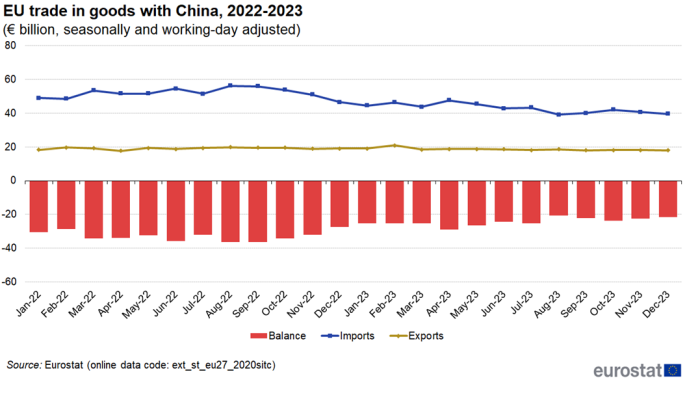
(€ billion, seasonally and working-day adjusted)
Source: Eurostat (ext_st_eu27_2020sitc)
Figure 2 compares EU trade with China against EU trade with other non-EU countries. Between January 2022 and December 2023, EU imports from China decreased by 19.0 %. Imports from other non-EU countries (-5.9 %) dropped less strongly. EU exports to China decreased by 1.5 % while exports to other non-EU countries increased by 5.5 %.
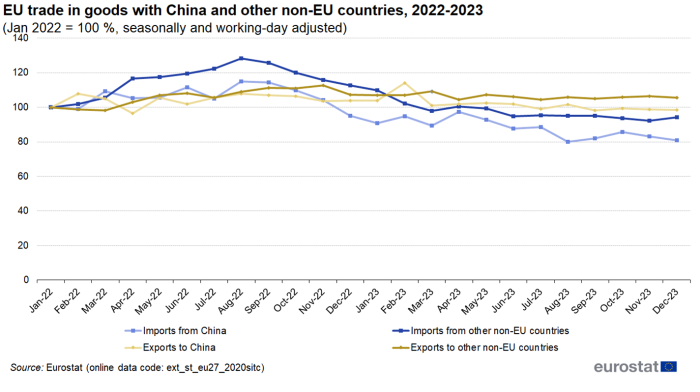
(Jan 2022 = 100 %, seasonally and working-day adjusted)
Source: Eurostat (ext_st_eu27_2020sitc)
EU and China in world trade in goods
Figure 3 shows the world's largest traders of goods. China (€3 413 billion, 17.6 %) was the largest exporter in the world, followed by the EU (€2 572 billion, 13.2 %), the United States (€1 960 billion, 10.1 %), Japan (€709 billion, 3.6 %) and South Korea (€649 billion, 3.3 %). China (€2 579 billion, 12.7 %) was the third largest importer in the world, preceded by the United States (€3 206 billion, 15.8 %) and the EU (€3 007 billion, 14.8 %) and followed by Japan (€852 billion, 4.2 %) and the United Kingdom (€782 billion, 3.9 %).
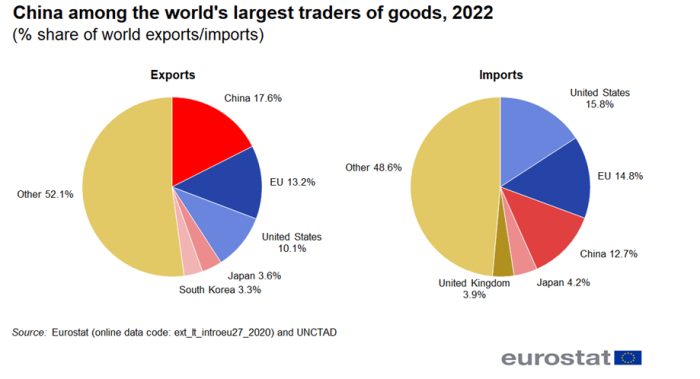
(% share of world exports/imports)
Source: Eurostat (ext_lt_introeu27_2020) and UNCTAD
The imports and exports of goods of the EU and China indexed at 100 in 2012 for the period to 2022 are shown in Figure 4. It also shows the cover ratio (exports / imports) for this period. Exports from the EU were lowest in 2012 (100) and highest in 2022 (145). Imports to the EU were lowest in 2016 (94) and highest in 2022 (177). The cover ratio for the EU was lowest in 2022 (86 %) and highest in 2016 (116 %). Exports from China were lowest in 2012 (100) and highest in 2022 (175). Imports to China were lowest in 2016 (87) and highest in 2022 (149).
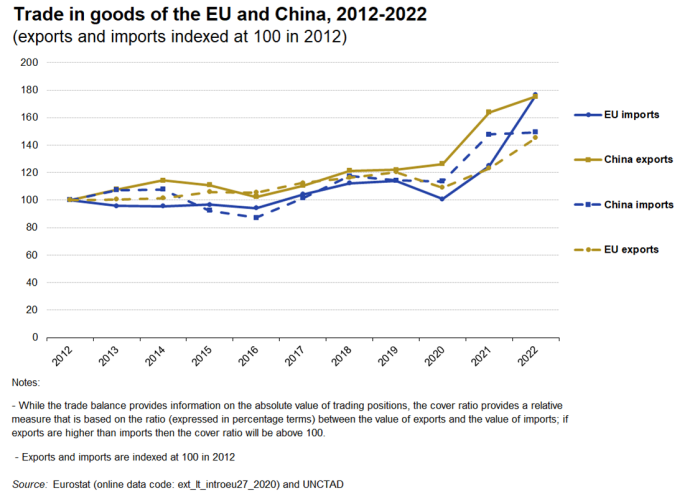
(exports and imports indexed at 100 in 2012, cover ratio in %)
Source: Eurostat (ext_lt_introeu27_2020) and UNCTAD
China largest partner for EU imports of goods in 2023
The position of China among the largest trade partners of the EU in 2023 can be seen in Figure 5. In 2023, China was the third largest partner for EU exports of goods (8.8 %). It was preceded by the United States (19.7 %) and the United Kingdom (13.1 %) and followed by Switzerland (7.4 %) and Türkiye (4.4 %). In 2023, China was the largest partner for EU imports of goods (20.5 %), followed by the United States (13.7 %), the United Kingdom (7.2 %), Switzerland (5.5 %) and Norway (4.7 %).
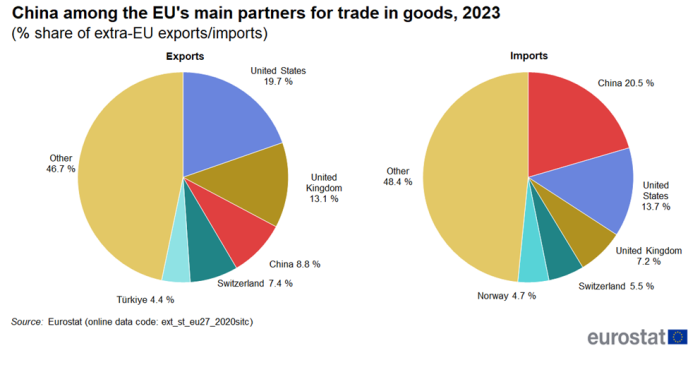
(% share of extra-EU exports/imports)
Source: Eurostat (ext_st_eu27_2020sitc)
EU-China trade by type of goods
The breakdown of EU trade with China by SITC groups is shown in Figure 6. The red shades denote the primary goods: food & drink, raw materials and energy, while the blue shades show the manufactured goods: chemicals, machinery & vehicles and other manufactured goods. Finally, other goods are shown in green. In 2023, EU exports of manufactured goods (88 %) had a much higher share than primary goods (11 %). The most exported manufactured goods were machinery & vehicles (51 %), followed by other manufactured goods (19 %) and chemicals (18 %). In 2023, EU imports of manufactured goods (97 %) also had a much higher share than primary goods (3 %). The most imported manufactured goods were machinery & vehicles (57 %), followed by other manufactured goods (31 %) and chemicals (8 %).
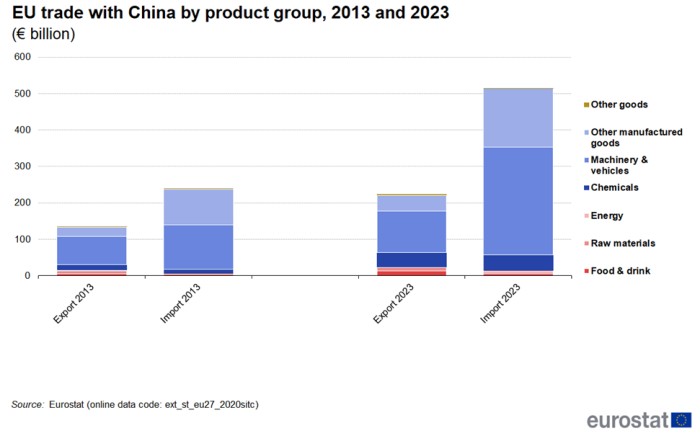
(€ billion)
Source: Eurostat (ext_st_eu27_2020sitc)
Figure 7 shows the evolution of EU imports and exports by SITC group since 2013. In 2023, the EU had trade surpluses in other goods (€1.9 billion), raw materials (€6.3 billion) and food & drink (€7.0 billion). By contrast, the EU had trade deficits in chemicals (€3.6 billion), energy (€3.8 billion), other manufactured goods (€118.3 billion) and machinery & vehicles (€180.4 billion).
EU-China most traded goods
More detail about the goods imported by the EU from China is given in Figure 8, showing the 20 most imported goods at SITC-3 level. These top 20 goods covered 61 % of total imports from China in 2023. Twelve belonged to machinery and vehicles, seven to other manufactured goods and one to chemicals. The most traded group of goods at this level was telecommunications equipment.
Figure 9 shows the 20 most exported goods at SITC-3 level. These top 20 goods covered 58 % of total exports to China in 2023. Motor cars and motor vehicles remained the top exported product to China in 2023, even though exports decreased by €4.8 billion compared with 2022. Medicaments growing by €4.3 billion and other machinery growing by €4.6 billion were the second and third largest exported products to China by the EU, respectively.
Trade with China by EU Member State
Table 1a shows the imports of goods from China by EU Member State. The three largest importers from China in the EU were the Netherlands (€117 billion), Germany (€95 billion) and Italy (€48 million). Czechia (43.7 %) had the highest share for China in its extra-EU imports.
Table 1b shows the exports of goods to China by EU Member State. The three largest exporters to China in the EU were Germany (€97 billion), France (€25 billion) and the Netherlands (€22 billion). Germany (13.6 %) had the highest share for China in its extra-EU exports.
The trade in goods balance between the EU Member States and China is shown in Table 1c. It shows that only Germany, Finland
Ireland and Luxembourg had trade surpluses with China. The other 23 EU Member States all had trade deficits with China. The largest deficit was held by the Netherlands (€95 billion).
Source data for tables and graphs
Data sources
EU data is taken from Eurostat's COMEXT database. COMEXT is the reference database for international trade in goods. It provides access not only to both recent and historical data from the EU Member States but also to statistics of a significant number of non-EU countries. International trade aggregated and detailed statistics disseminated via the Eurostat website are compiled from COMEXT data according to a monthly process.
Data are collected by the competent national authorities of the EU Member States and compiled according to a harmonised methodology established by EU regulations before transmission to Eurostat. For extra-EU trade, the statistical information is mainly provided by the traders on the basis of customs declarations.
EU data are compiled according to EU guidelines and may, therefore, differ from national data published by the Member States. Statistics on extra-EU trade are calculated as the sum of trade of each of the 27 EU Member States with countries outside the EU. In other words, the EU is considered as a single trading entity and trade flows are measured into and out of the area, but not within it.
Dutch trade flows are over-estimated because of the so-called 'Rotterdam effect' (or quasi-transit trade): goods bound for other EU countries arrive in Dutch ports and, according to EU rules, are recorded as extra-EU imports by the Netherlands (the country where goods are released for free circulation). This in turn increases the intra-EU flows from the Netherlands to those Member States to which the goods are re-exported.
Data for the non-EU countries used in Figures 3 and 4 are taken from the UNCTAD database of the United Nations. For the calculation of shares, the world trade is defined as the sum of EU trade with non-EU countries (source: Eurostat) plus the international trade of non-EU countries (source: UNCTAD).
Methodology
According to the EU concepts and definitions, extra-EU trade statistics (trade between EU Member States and non-EU countries) do not record exchanges involving goods in transit, placed in a customs warehouse or given temporary admission (for trade fairs, temporary exhibitions, tests, etc.). This is known as 'special trade'. The partner is the country of final destination of the goods for exports and the country of origin for imports.
Product classification
Information on commodities exported and imported is presented according to the Standard international trade classification (SITC). A full description is available from Eurostat's classification server RAMON.
Unit of measure
Trade values are expressed in millions or billions (109) of euros. They correspond to the statistical value, i.e. to the amount which would be invoiced in the event of sale or purchase at the national border of the reporting country. It is called a FOB value (free on board) for exports and a CIF value (cost, insurance, freight) for imports.
Context
Trade is an important indicator of Europe's prosperity and place in the world. The bloc is deeply integrated into global markets both for the products it sources and the exports it sells. The EU trade policy is one of the main pillars of the EU's relations with the rest of the world.
Because the 27 EU Member States share a single market and a single external border, they also have a single trade policy. EU Member States speak and negotiate collectively, both in the World Trade Organisation, where the rules of international trade are agreed and enforced, and with individual trading partners. This common policy enables them to speak with one voice in trade negotiations, maximising their impact in such negotiations. This is even more important in a globalised world in which economies tend to cluster together in regional groups.
The openness of the EU's trade regime has meant that the EU is the biggest player on the global trading scene and remains a good region to do business with. Thanks to the ease of modern transport and communications, it is now easier to produce, buy and sell goods around the world which gives European companies of every size the potential to trade outside Europe.
Direct access to
